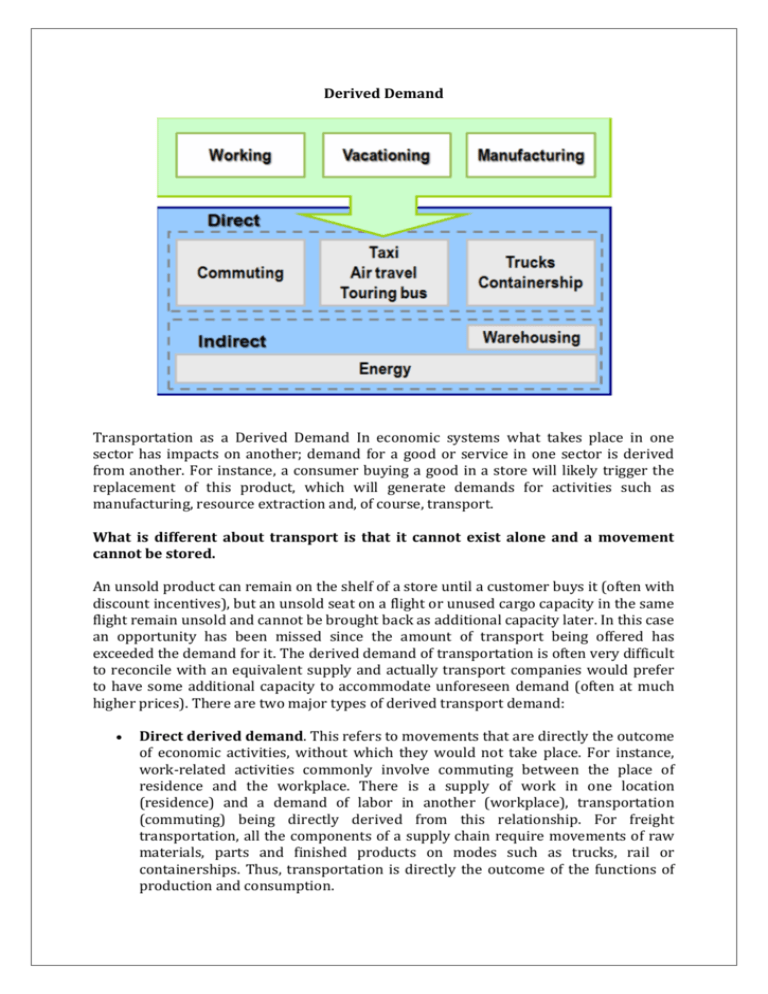Transportation as a Derived Demand In economic systems
advertisement

Derived Demand Transportation as a Derived Demand In economic systems what takes place in one sector has impacts on another; demand for a good or service in one sector is derived from another. For instance, a consumer buying a good in a store will likely trigger the replacement of this product, which will generate demands for activities such as manufacturing, resource extraction and, of course, transport. What is different about transport is that it cannot exist alone and a movement cannot be stored. An unsold product can remain on the shelf of a store until a customer buys it (often with discount incentives), but an unsold seat on a flight or unused cargo capacity in the same flight remain unsold and cannot be brought back as additional capacity later. In this case an opportunity has been missed since the amount of transport being offered has exceeded the demand for it. The derived demand of transportation is often very difficult to reconcile with an equivalent supply and actually transport companies would prefer to have some additional capacity to accommodate unforeseen demand (often at much higher prices). There are two major types of derived transport demand: Direct derived demand. This refers to movements that are directly the outcome of economic activities, without which they would not take place. For instance, work-related activities commonly involve commuting between the place of residence and the workplace. There is a supply of work in one location (residence) and a demand of labor in another (workplace), transportation (commuting) being directly derived from this relationship. For freight transportation, all the components of a supply chain require movements of raw materials, parts and finished products on modes such as trucks, rail or containerships. Thus, transportation is directly the outcome of the functions of production and consumption. Indirect derived demand. Considers movements created by the requirements of other movements. The most obvious example is energy where fuel consumption from transportation activities must be supplied by an energy production system requiring movements from zones of extraction, to refineries and storage facilities and, finally, to places of consumption. Warehousing can also be labelled as an indirect derived demand since it is a "non movement" of a freight element. Warehousing exists because it is virtually impossible to move commodities instantly from where they are produced to where they are consumed. Transportation can also be perceived as an induced (or latent) demand which represents a demand response to a reduction in the price of a commodity. This is particularly the case in the context where the addition of transport infrastructures results in traffic increases due to higher levels of accessibility. Roadway congestion is partially the outcome of induced transport demand as additional road capacity results in mode shifts, route shifts, redistribution of trips, generation of new trips, and land use changes that create new trips as well as longer trips. However, the induced demand process does not always take place. For instance, additional terminal capacity does not necessarily guarantee additional traffic as freight forwarders are free to select terminals they transit their traffic through, such as it is the case for maritime shipping. What is transport demand? The demand for transport is a derived demand, an economic term, which refers to demand for one good or service in one sector occurring as a result of demand from another. Users of transport are primarily consuming the service not because of its direct benefits, but because they wish to access other services. Transport demand is about the movement of people and goods and we travel in order to satisfy a need (work, education, recreation etc) and we transport goods as part of the overall economic activity. So for example, work-related activities commonly involve commuting between the place of residence and the workplace. There is a supply of work in one location (residence) and a demand of labour in another (workplace), transport (commuting) being directly derived from this relationship, hence a derived demand. Transport can also be perceived as an induced or latent demand, that is a demand response to the addition of transport infrastructure results in traffic volume increases. In economic terms this is due to the reduction in the price of a commodity, in the transport context an increased mobility, results in the lower perceived cost of travel (reduced travel time or delay or improved reliability), hence increase in demand. Additional road capacity results in mode shifts, route shifts, redistribution of trips, and generation of new trips as well as longer trips.







